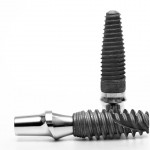
Platform switching, where the abutment has a smaller diameter than the implant platform is receiving increasing interest as it has been suggested that this may have a positive impact on marginal bone levels. The aim of this review was to assess if there was a difference in the implant failure rates, marginal bone loss (MBL) and postoperative infection in patients who received platform-switched implants or platform-matched implants.
Methods
Searches were conducted in the Pubmed/Medline, Web of Science, Cochrane Oral Health Group Trials Register, clinicaltrials.gov; www.centerwatch.com/clinicaltrials; and www.clinicalconnection.com databases. This was supplemented by handsearching of a wide range of journals. Studies (randomised or no) comparing implant failure rates, marginal bone level (MBL) and/or postoperative infection in any group of patients receiving platform-switched implants or platform-matched implants were considered. Study quality was assessed with the Newcastle-Ottawa scale (NOS).
Results
- 28 studies (18 RCTs, 6 CCTs and 4 retrospective analyses) were included.
- 26 studies were considered to be of high quality.
- 1216 platform-switched implants were included with 16 failures (1.32%) and 1157 platform-matched implants and 13 failures (1.12%).
- 20 studies had no implant failures.
- In a meta-analysis for the outcome MBL (18-RCTs) -There was less MBL loss at implants with platform-switching than at implants with platform-matching (mean difference -0.29, 95% CI -0.38 to -0.19; P<0.00001)
Conclusions
The authors concluded:
The results of the present study suggest that there is a significantly less MBL at implants with platform-switching than on implants with platform-matching. The results of the present review should be interpreted with caution due to the presence of uncontrolled confounding factors in the included studies, most of them with short follow-up periods.
Comments
The broad search strategy has been used to identify relevant articles and a significant number of RCTs have been identified. However, the authors have used the Newcastle-Ottawa scale typically used for cohort studies and case controlled studies rather than a tool such as the Cochrane risk of bias tool, which is more typically used for RCTs. The authors note that the majority of the studies were of short duration with only 4 of those included in the meta-analysis being over 3 years duration. This explains the low number of implant failures and fact that meta-analyses were not performed on that outcome. The authors also noted a large variation in implant-abutment connection type as well as different brands and surface type. Consequently they recommend that their results should be interpreted with caution.
Links
Chrcanovic BR, Albrektsson T, Wennerberg A. Platform switch and dental implants: A meta-analysis. J Dent. 2015 Jan 2. pii: S0300-5712(14)00353-4. doi: 10.1016/j.jdent.2014.12.013. [Epub ahead of print] Review. PubMed PMID: 25559693.

Platform switching of dental implants may improve marginal bone loss – http://t.co/q3JqqJFORX
Platform switching of dental implants evidence needs cautious interpretation – http://t.co/q3JqqJFORX
Cautious interpretation of evidence for Platform switching of dental implants needed-http://t.co/q3JqqJFORX
Platform switching of dental implants show benefit in short term – http://t.co/q3JqqJFORX
Don’t miss – Dental implants: platform switching and bone loss – http://t.co/q3JqqJFORX
[…] Dental Elf -1st May 2015 – Dental implants: platform switching may decrease bone loss […]